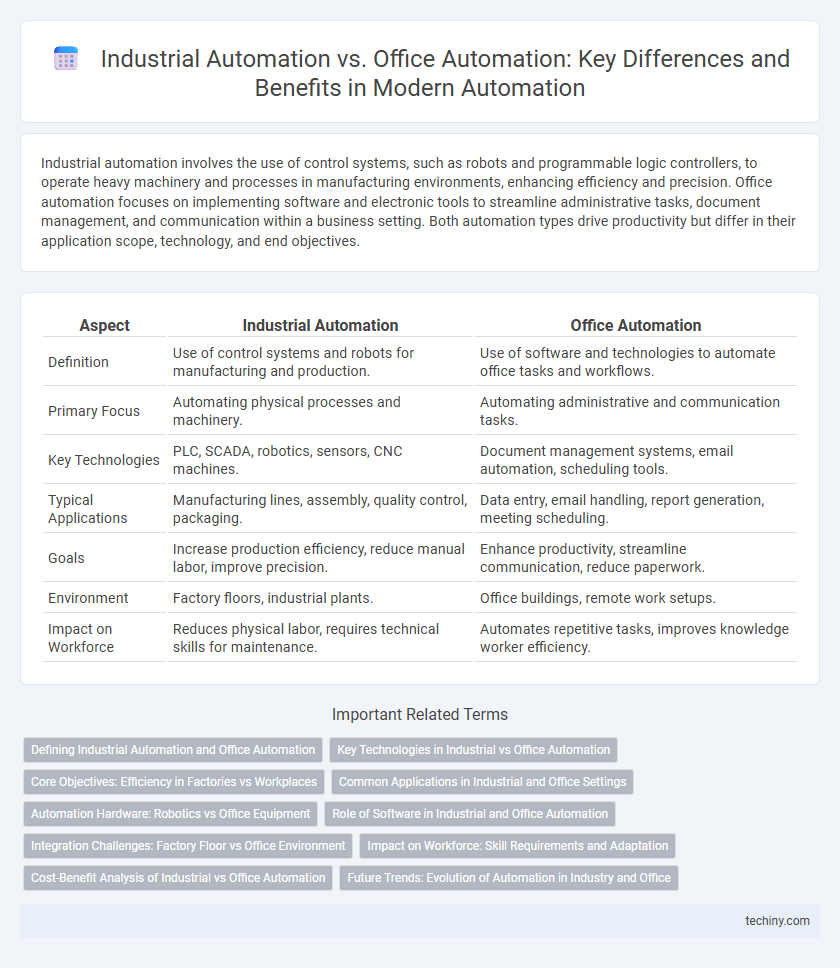Industrial automation involves the use of control systems, such as robots and programmable logic controllers, to operate heavy machinery and processes in manufacturing environments, enhancing efficiency and precision. Office automation focuses on implementing software and electronic tools to streamline administrative tasks, document management, and communication within a business setting. Both automation types drive productivity but differ in their application scope, technology, and end objectives.
Table of Comparison
| Aspect | Industrial Automation | Office Automation |
|---|---|---|
| Definition | Use of control systems and robots for manufacturing and production. | Use of software and technologies to automate office tasks and workflows. |
| Primary Focus | Automating physical processes and machinery. | Automating administrative and communication tasks. |
| Key Technologies | PLC, SCADA, robotics, sensors, CNC machines. | Document management systems, email automation, scheduling tools. |
| Typical Applications | Manufacturing lines, assembly, quality control, packaging. | Data entry, email handling, report generation, meeting scheduling. |
| Goals | Increase production efficiency, reduce manual labor, improve precision. | Enhance productivity, streamline communication, reduce paperwork. |
| Environment | Factory floors, industrial plants. | Office buildings, remote work setups. |
| Impact on Workforce | Reduces physical labor, requires technical skills for maintenance. | Automates repetitive tasks, improves knowledge worker efficiency. |
Defining Industrial Automation and Office Automation
Industrial Automation involves the use of control systems, such as robots, computers, and information technologies to handle different processes and machinery in manufacturing and production environments. Office Automation refers to the integration of hardware and software solutions to streamline office tasks, including document management, communication, and data storage. Both forms of automation aim to increase efficiency but serve distinct operational purposes within industrial and administrative settings.
Key Technologies in Industrial vs Office Automation
Industrial Automation leverages technologies such as Programmable Logic Controllers (PLCs), Supervisory Control and Data Acquisition (SCADA) systems, and robotic process automation to enhance manufacturing efficiency and precision. Office Automation primarily employs software suites like Microsoft Office 365, cloud computing platforms, and CRM systems to streamline administrative tasks and improve collaboration. While Industrial Automation focuses on hardware integration and real-time control, Office Automation centers on digital workflows and information management tools.
Core Objectives: Efficiency in Factories vs Workplaces
Industrial automation focuses on maximizing efficiency in factories by streamlining production processes, reducing manual labor, and enhancing precision through robotics and control systems. Office automation aims to improve workplace efficiency by automating administrative tasks, managing information flow, and enabling seamless communication using software tools and digital platforms. Both fields prioritize operational optimization but target distinct environments and functional goals.
Common Applications in Industrial and Office Settings
Industrial automation commonly involves robotics, programmable logic controllers (PLCs), and automated assembly lines to enhance manufacturing efficiency and precision. Office automation typically includes software tools for data management, communication platforms, and workflow automation systems designed to streamline administrative tasks. Both settings leverage automation to reduce human error, increase productivity, and optimize operational workflows.
Automation Hardware: Robotics vs Office Equipment
Industrial automation relies heavily on advanced robotics, including robotic arms, programmable logic controllers (PLCs), and sensors designed for manufacturing efficiency and precision. Office automation primarily employs office equipment such as printers, scanners, and multifunction devices integrated with software systems for workflow optimization. The significant hardware difference lies in robotics enabling physical task automation in industries, whereas office automation focuses on digital document and communication management tools.
Role of Software in Industrial and Office Automation
Software in industrial automation drives precision and efficiency through programmable logic controllers (PLCs), supervisory control and data acquisition (SCADA) systems, and robotics programming, enabling real-time monitoring and control of manufacturing processes. In office automation, software enhances productivity with document management systems, communication platforms, and workflow automation tools that streamline repetitive administrative tasks and improve collaboration. The role of software is pivotal in both domains, tailored to optimize hardware interaction in industrial settings and facilitate information management in office environments.
Integration Challenges: Factory Floor vs Office Environment
Industrial automation involves complex machinery and real-time control systems that require seamless integration of hardware and software, posing significant challenges in synchronization and data consistency on the factory floor. Office automation primarily deals with software applications and networked devices, where integration hurdles often stem from compatibility between diverse business software and security protocols. Both environments demand tailored integration strategies, but industrial settings emphasize robustness and uptime, while office automation prioritizes user interface and workflow optimization.
Impact on Workforce: Skill Requirements and Adaptation
Industrial automation transforms manufacturing roles by requiring advanced technical skills such as robotics programming, machine maintenance, and process optimization, leading to workforce upskilling and specialized training programs. Office automation emphasizes proficiency in software tools, data management, and digital communication, prompting employees to adapt through continuous learning and digital literacy development. Both sectors face workforce adaptation challenges, with industrial automation driving the need for STEM expertise and office automation accelerating demand for IT competencies and agile work practices.
Cost-Benefit Analysis of Industrial vs Office Automation
Industrial automation typically demands higher initial capital investment due to expensive machinery, robotics, and integrated control systems, but offers substantial long-term savings through increased production efficiency, reduced labor costs, and minimized human error. Office automation involves comparatively lower upfront costs, focusing on software solutions like document management, communication tools, and workflow automation, which enhance productivity and reduce administrative overhead. Cost-benefit analysis reveals that industrial automation yields significant returns in large-scale manufacturing environments, while office automation provides rapid, cost-effective improvements primarily in operational efficiency and time savings.
Future Trends: Evolution of Automation in Industry and Office
Industrial automation is rapidly advancing with AI-driven robotics and IoT integration, enabling predictive maintenance and real-time process optimization that significantly enhance manufacturing efficiency. Office automation is evolving through AI-powered virtual assistants, intelligent document processing, and cloud-based collaboration tools, streamlining workflows and boosting productivity across remote and hybrid work environments. The convergence of AI, machine learning, and cloud computing is driving the future of automation by creating smarter, adaptive systems tailored to both industrial manufacturing and office operations.
Industrial Automation vs Office Automation Infographic

 techiny.com
techiny.com